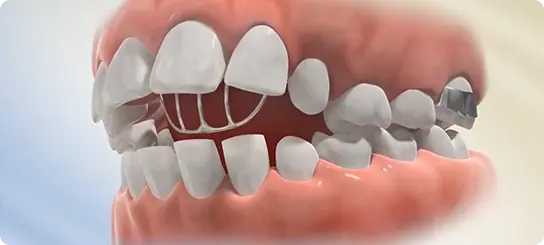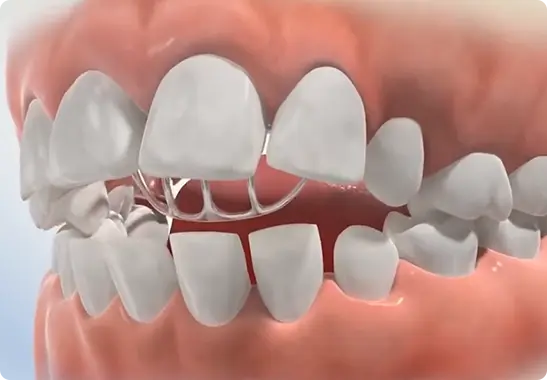TONGUE CRIB APPLIANCE
TONGUE CRIB APPLIANCE
How a Tongue Crib Appliance Can Help (Tongue Crib for Adults)
Table Of Contents:
- Tongue Crib: Definition, Effects, and Proper Use!
- What Is Tongue Thrusting And Do You Have To Treat It?
- What Does A Tongue Crib Do?
- How Effective Is Tongue Crib
- What Does A Tongue Crib Do/ Thumb Crib Look Like
- Can Adult And Children Wear A Tongue Appliance, Is It Painfull To Wear
- What Can I Do As Prevention
- Can I Remove My Tongue Crib
- Can Other See My Tounge Crib
Tongue Crib:Definition, Effects, and Proper Use!
Nowadays, correctional dentistry is more advanced than it ever was before. In fact, dentist and orthodontist offer a variety of tools which help with teeth and jaw alignment. Such are, for instance, braces, retainers, tongue crib adults, and others. And while other tools, like tongue thrust braces, get the entire attention in terms of popularity, braces tongue crib (tongue guard) gets very little. Tongue crib represents one of the more traditional methods to keep the teeth aligned. Mostly, doctors recommend wearing tongue crib for adults during childhood. With this, tongue crib can help prevent actions like tongue thrust appliance or thumb sucking.
Usually, the duration for patients who wear a tongue crib ortho is around nine months. The tongue crib adults gets fastened and bonded to your teeth and one needs to wear it every day. A dentist or orthodontist can give you further details related to the same. Below, let’s discuss tongue guard for braces, its purposes and whether you should use it or not. First, let’s begin with defining tongue thrusting. Learn More about other orthodontic appliances that can help at https://ivanovortho.com/teeth-straightening-types-of-orthodontic-appliances/
What is Tongue Thrusting and Do You Have to Treat It?

Tongue thrusting represents a reflex action of pushing your tongue against your upper teeth. In time, tongue thrusting can cause the need for wearing a tongue crib. Tongue thrusting is a serious issue in both adults and children, and a one you shouldn’t ignore. What is more, a tongue thrust has to be addressed as soon as it becomes a symptom.
Tongue thrusting is commonly a reflex acquired after birth or breastfeeding. The same habit can develop if children use baby bottles and/or pacifiers for too long. If tongue thrusting is not managed on time, it can lead to serious oral health problems. For one, it will change the way your facial muscles develop. Next, it will leave more room for bacteria and infections. It can also cause cavities and tooth decay and will urge the need for tongue crib even further.
What Is Tongue Crib? What Does it Do?
Tongue crib is an orthodontic tool which has similar wiring as braces, but it not fixed. This appliance lies inside the oral cavity and hangs on two rings. The rings are attached to the back of the mouth, so the tongue crib doesn’t move. This action also helps prevents the tongue from pushing against the teeth and causing additional issues. A tongue crib serves server purposes as an orthodontic tool. Initially, it puts an end to tongue thrusting and front teeth protrusion. Next, it diminishes the effects of thumb sucking and using a pacifier.
A tongue crib is installed on the first molars of the jaw and has to be worn at all times to show effects. Depending on the seriousness of the condition, a patient can wear it for a few months, if necessary. Many dentists use this appliance as a treatment before putting on braces.
By wearing a tongue crib earlier, you can potentially fix bad habits and any swallowing and/or speech issues, too.
How effective is a Tongue Crib?
As stated before, tongue cribs don’t receive the desired attention. One of the reasons this is so is because many consider the treatment not as impactful. At the same time, many other dentists encourage and recommend wearing a tongue crib. The doubters consider tongue cribs too radical on the teeth, forcing them into their natural place. As they explain it, the teeth have to take time in adapting to the new situation.
Another aspect that does not make a tongue crib as effective, is its impact. Namely, a tongue crib does not necessarily straighten your teeth, like braces do. Instead, it only focuses on preventing your tongue from pushing your teeth forward and creating overbite, whether on the lower or bottom jaw. However, a tongue crib is mostly used for the top teeth. You are probably thinking how to fix an overbite after tongue habit. There are many orthodontic solutions that you can look into and are be effective in life with braces before and after overbite. When used right and in a committed manner, tongue crib can help your oral health a lot. Moreover, the tool is safe to use and does not cause side-effects as severe as in wearing braces.
What Does a Tongue Crib Do/ thumb crib look like?
A fixed tongue crib is made of two bands, connected with a wire that prevents the tongue from pushing the teeth forward or prevent the thumb from being in the mouth comfortably. It is a small appliance made specifically for a patient’s teeth by his or her dentist. If your orthodontist chooses to use removable appliance, it should not be confused with removable hawley retainers. Hawley retainer does not have the tongue specific feature. As tiny as it may look like, a tongue crib is very useful in improving swallowing reflexes, too. If there is a crossbite as well, this appliance can be combined with palatal expander to save orthodontic treatment time.

Can adults and children wear a tongue appliance? Is it painful to wear?
Both children and adults can use tongue cribs as oral treatment. Wearing a tongue crib is not unpleasant, nor painful. As it is a strange object in your mouth, it will take time getting accustomed to it. Usually, length of time the patients wear a tongue crib is no less than nine months. The tool is attached and cemented to your teeth and you will have to wear it daily. Your dentist or orthodontist can give you a clear diagnosis and suggest a follow-up treatment.
What can I do as prevention?
If you undergo a tongue crib treatment, read how you can facilitate the process even more.
- Make sure your tongue stays behind the wire gate the fixed appliance creates. Even if you feel sore, put up with the discomfort for a few days. If the pain is unbearable, take a mild over-the-counter drug or a similar painkiller.
- If you wear fixed tongue crib, steer clear of chewy foods, like bubble gum, gummy bears, and sugary products.
- Keep the oral hygiene high and brush and floss your teeth regularly. Massage the gums as well, and gargle regularly to avoid infection.
- If you are wearing elastic bands as well, make sure you remove and replace them accordingly before eating.
- If you lose one of your rubber bands, get it replaced as soon as possible.
- Know that you will have to wear the appliance for at least 22 hours per day. Make sure you clean and rinse it accordingly so you prevent bacteria. Furthermore, clean the tongue crib with toothpaste separately to eliminate its smell and offer best oral protection.
- Ask your doctor to remove any excessive teeth plaque and treat possible cavities as soon as possible.
- Avoid using rigid mouthwash solutions, as these may cause the tongue crib to rust.
Most importantly, before initiating any sort of a dental treatment, do your research. Be sure that your teeth get the best care available, and make the most of today’s available dental treatments.
Can I remove my tongue crib?
A tongue crib is a removable tool that is devised to restrict tongue behavior or to tame bad oral habits or both.
Can others see my tongue crib?
A tongue crib is a removable tool that is devised to restrict tongue behavior or to tame bad oral habits or both.
AMERICA'S TOP DENTIST
Tongue Thrusting
When babies suck their thumbs, it is not seen as too much of a problem – it’s just a thing they all seem to do. Some people do not think that an older child sucking its thumb is an issue, but it can lead to problems when it comes to tooth formation. Tongue thrusting is also a problem as it can cause the same poor formation of the front teeth when they start to come through. There are many dental appliance for tongue thrusting and the tongue crib appliance is made up of the same materials as the others. It is just put together in a different way.
If the tongue habits persist, it will be necessary to wear tongue crib appliance for many hours of treatment or use some of the other appliances. With a tongue crib appliance, there are wires and bands that are constructed in a way so that they resemble a gate. The gate will act as a way of remembering not to suck your thumb. When it is used to prevent tongue thrust, it will act as an aid to keep the tongue in place while swallowing takes place.
The First Appointment
It is hard to tell how long an appliance will have to be worn. As it is placed in the mouth and cemented into place, it will not be possible to take it out at will. Each case will be different so one person may have to wear a tongue crib appliance a lot longer than another. It will depend upon the severity of the case and the amount of time it takes will be determined by the orthodontist. There is little that you have to do other than to keep the tongue behind the fence and while this may not seem easy at first, you should be able to do it after a short period of time.
You also have to be careful when it comes to eating as this appliance is not as easy to clean as others. They can be removed, and the teeth can be accessed, here some teeth will not be reached properly by the tooth brush. Although this is not going to be a very painful process, there is the likelihood that there will be a little pain felt in the tongue for the first few days after the tongue crib appliance has been fitted. It is your responsibility to look after the crib and in order to do this you can:
- Take medication as and when needed at the beginning; but if pain last too long, speak to the orthodontist and check that everything is in order.
- Don’t eat any food that is hard and may break the tongue crib appliance.
- Avoid items that have high sugar content.
- Carefully clean the appliance whenever you have eaten and cover all areas.
- Ensure that the bands are firmly in place and check this daily.
- Whenever you have any problems contact your orthodontist for help.
Learn More about teeth straightening and orthodontic appliances for children at https://ivanovortho.com/teeth-straightening-types-of-orthodontic-appliances/
FIVE-STAR PATIENT TESTIMONIALS









